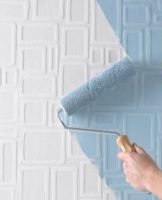Types and 6 main manufacturers of acrylic paints for facades, how to apply them
Acrylic paint for facade work is applied at the finishing stage. The appearance of the house depends on the color and quality of this paint and varnish material. It can be in the form of an aqueous dispersion or in organic solvents. It is considered the most environmentally friendly and popular paint. This painting tool has many positive features. It is inexpensive, easy to use and quite durable.
Advantages and disadvantages of using acrylic paint for outdoor use
Advantages of using polyacrylic paint materials:
- the composition is sold completely ready for painting the facade;
- if necessary, diluted with plain water or solvent;
- the composition is sold in white, but can be tinted with pigment in any shade;
- in the process of painting, it instantly fixes on a vertical surface, does not flow;
- dries relatively quickly after application (within 30-120 minutes);
- after drying, the coating becomes resistant to prolonged exposure to water;
- the painted coating is vapor permeable (the facade can breathe);
- the composition has good covering power (2 coats of paint are sufficient);
- does not contain toxic and flammable substances;
- UV resistant coating that does not fade in the sun;
- protects the surface from moisture penetration for a long time (more than 10 years);
- the painted facade can withstand sudden temperature changes;
- the composition itself has excellent adhesion to various types of surfaces.
Disadvantages of using paint materials:
- before painting, the white composition will need to be tinted to the desired shade;
- when coloring, a fresh stain can be removed with water, but after the paint has dried, a solvent will be needed to correct defects;
- the complete drying time (polymerization process) is 24 hours, during this period the surface must be protected from rain;
- it is recommended to prepare and prime the surface before painting with an acrylic primer.
Varieties of compositions
Paint material manufacturers produce two main types of acrylic paint materials for different types of surfaces: water-based (dispersion) and organic solvent-based. Acrylic adheres equally well to concrete, brick, wood, plaster or cement plaster.
For facade works
Types of acrylic paint materials for the facade:
- water-based dispersions (diluted with water);
- on organic solvents (diluted with a solvent, characterized by increased resistance to weathering).
To give the paint the desired shade, all sorts of pigments are used, which are added to the acrylic composition before work.Tinting can be done by yourself or ordered from the store. After applying acrylic paint and varnish to the surface, a durable layer is formed, characterized by resistance to precipitation.
On paint materials intended for painting facades, there should be an inscription “for facade work”. Such compositions are distinguished by their increased resistance to various weather conditions. They have a long service life and are guaranteed to be able to finish painting in the short term. Acrylic paints and varnishes may contain various additives that give the painted surface a smooth, glossy or structural (textured) appearance.
It is possible to work with water-based acrylic at temperatures of +15 degrees Celsius and above, and the air humidity should not exceed 65%. It is forbidden to paint the facade in the rain. Solvent-based paints and varnishes can be used even at low temperatures.
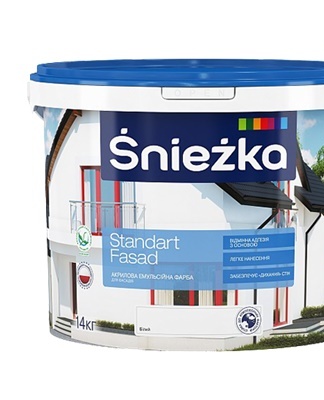
For wooden facades
For painting wood and wooden building materials, manufacturers produce a special type of acrylic dispersion, on the label of which there is the inscription “for wooden facades”. Such paint materials are diluted with water, are easy to apply and perfectly protect the wood from moisture.
For exterior concreting
Not all aqueous formulations are suitable for mineral surfaces such as concrete. The fact is that some paint and varnish materials, which do not pass steam, accumulate moisture inside the walls, which leads to the destruction of the base. Poorly breathable paints that are not intended for exterior work (façade) turn the plaster into a loose, damp mass.
For the facade, choose acrylic dispersion with high resistance to alkalis or acrylic paints based on organic solvents.They do not let moisture through, but allow the surface to breathe. These paint materials should be marked “for concreting”.
Popular manufacturers
For painting the facade, paint materials are usually purchased from well-established manufacturers. The products of these companies meet all the requirements for facade paints.
"Lakra"
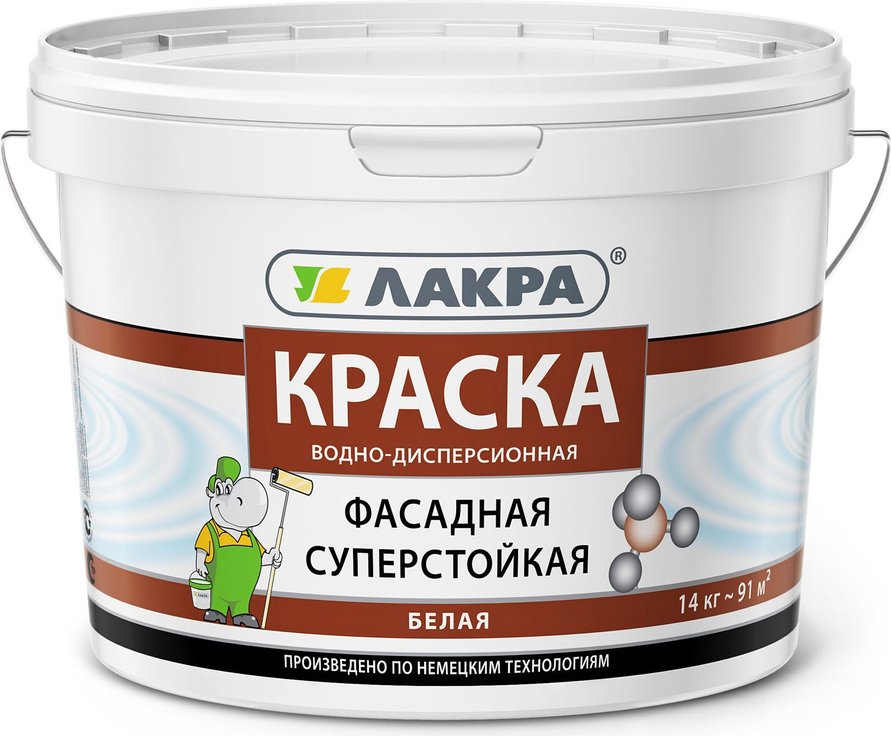
Some types of Lakra products and characteristics (table):
| Name | PARADE CLASSIC F20 (acrylic dispersion) | PARADE CLASSIC F30 (micro crack resistant dispersion)
| PARADE PROFESSIONAL F60 WOOD FRONT (for wooden fronts) |
| benefits | Gives a vapor permeable coating, resists ultraviolet light and weathering. Suitable for concrete, plaster, plaster, brick, wood. | Application in a thick layer is allowed, does not crack, has a slight shrinkage, hides small cracks, lets steam through, does not let moisture through. Suitable for all foundations. | Permeable to water vapor, resistant to humidity, adverse weather conditions, elastic, resistant to cracking. |
| Disadvantages | It is undesirable to paint at temperatures below +10 degrees. | Do not paint in the rain. | Interlaminar drying is 4 hours. |
"Ceresit"
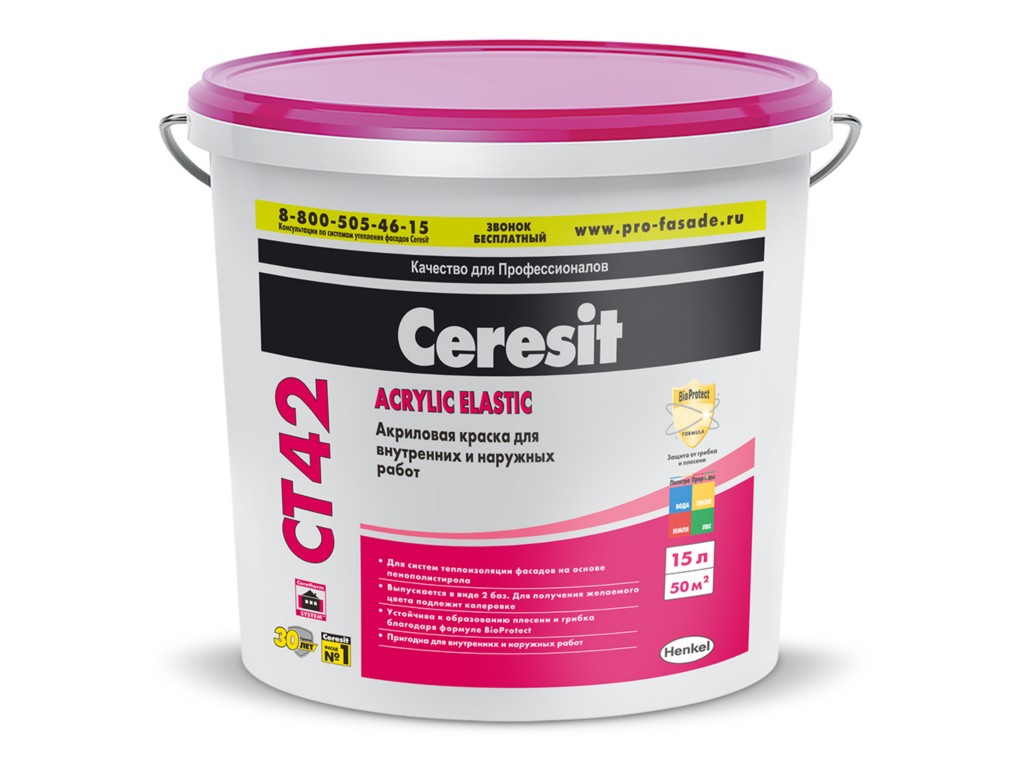
Some types of Ceresit products and their advantages (table):
| Painting name | Ceresit CT 42 (acrylic aqueous dispersion for exterior and interior use) | Ceresit CT 44 (acrylic aqueous dispersion for facades) |
| benefits | Vapor permeable, alkali resistant, does not let moisture through. | Vapor permeable, retains moisture, non-toxic. |
| Disadvantages | Available only in white (dye required). | Before use, tint in the desired shade. |
"Halo"
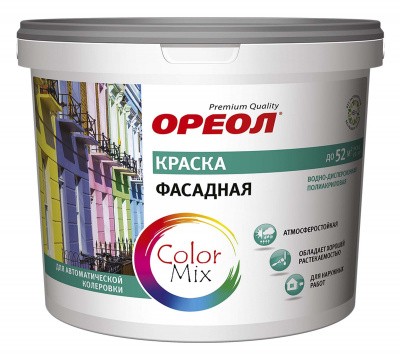
Some types of acrylic paints and varnishes and their characteristics (table):
| Product Name | "Halo" (facade paint) Base A | "Halo" (facade paint) Base C |
| benefits | Provides a breathable finish. Fade resistant (action of ultraviolet rays). Does not let moisture through. | Matte shine. Suitable for all surfaces. Impregnates steam, does not allow moisture to pass. Does not change color when exposed to ultraviolet rays. |
| Disadvantages | Available in white, tinting is required to provide shade. | In addition, you will need to order a tincture. |
Tikkurila
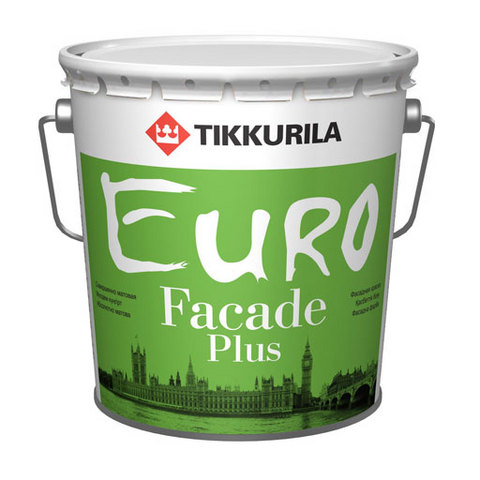
Some types of acrylic paints and their advantages (table):
| Painting name | Prof Facade Aqua (silicone modified acrylic) | Euro Facade (solvent-based, acrylic, for the facade) |
| benefits | High vapor permeability. Suitable for concrete, plaster or brick. Diluted with water. Protects the surface from moisture penetration. | Used for mineral surfaces. Diluted with solvent. Has high weather resistance. You can work with painting materials at negative temperatures. |
| Disadvantages | Available in basic color (white). High consumption for rough surfaces (1 liter per 4-6 square meters) | Has a pungent smell. The interval before applying the second coat is 5 hours. |
Akrial Lux
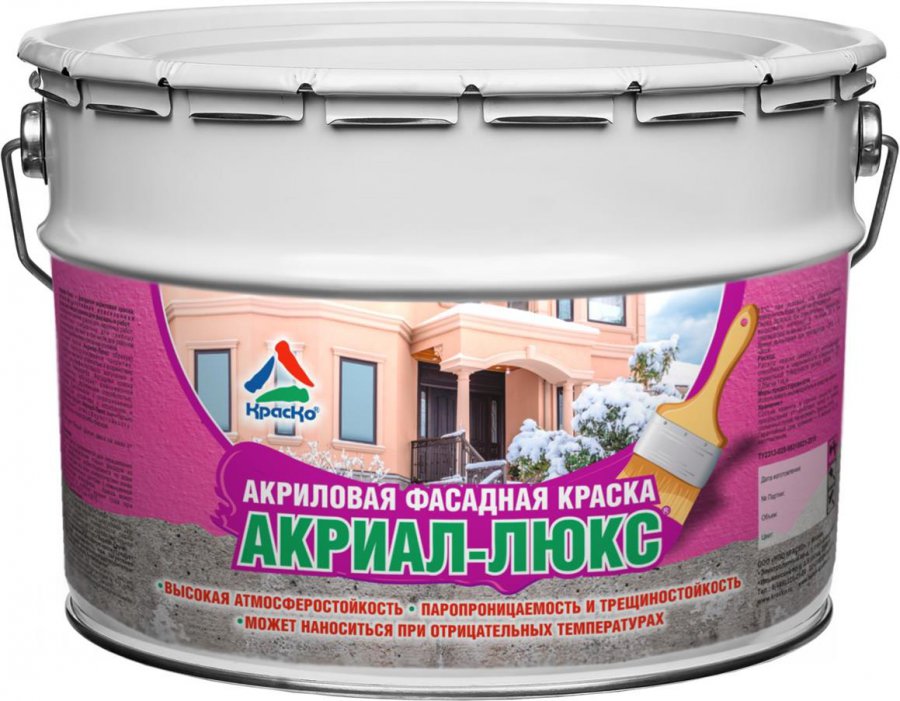
Some types of products and their advantages (table):
| Painting name | "Akrial-Lux" (acrylic, facade, frost-resistant) | "Facade-Lux" (aqueous acrylic dispersion) |
| benefits | Solvent-based paints and varnishes can be used in winter. It is used to paint concrete. Protects against humidity. Skip steam. | Forms a weather-resistant, strong and durable coating. Prevents spalling of concrete. |
| Disadvantages | Available in basic color (white). | Available in white, tinting is required. |
TRICOLOR (VD-AK-101 and others)
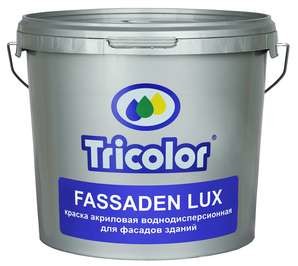
Some types of paints and varnishes from TRICOLOR and their characteristics:
| Product Name | "VD-AK-101 Extra" (acrylic aqueous dispersion, before) | "Facade-Acryl" (based on pliolite resins and solvent) |
| benefits | It is used on concrete and plaster surfaces. Dries in one hour. Forms a moisture resistant and vapor permeable coating. | Painting can be done at temperatures down to -20 degrees Celsius. Does not let moisture through, but allows you to "breathe". Does not fade in the sun. |
| Disadvantages | Requires additional tinting. | The interval before applying the next layer is at least 3 hours. Strong smell. |
How to correctly calculate the flow
Before buying acrylic paint materials, you need to calculate how much paint will be spent on painting the surface. The consumption of any paint and varnish product is measured in kilograms per square meter. Usually 1 kg is enough for 4-10 m². Mr. In order to find out the consumption of paint materials, you need to calculate the area of \u200b\u200bthe painted surface. It is calculated by multiplying the length by the width of the wall.
Preparatory work before painting
The facade must be prepared before painting. The walls are leveled, plastered, if necessary, cleaned of dust, dirt or old paint. The paint should be done on a smooth surface and not crumble. It is recommended to prime the wall with a deep penetration primer before applying the acrylic.
painting technique
For painting the facade, rollers, brushes or spray guns are used. Painting with acrylic paint materials is allowed at a temperature of -20 ... + 20 degrees Celsius (depending on the composition). It is forbidden to paint the facade in the rain. Paint materials are tinted and thoroughly mixed before use.
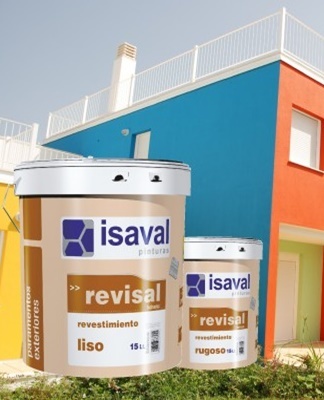
Staining a smooth surface starts from top to bottom in wide vertical stripes. If the wall is made of transverse boards, the painting is carried out horizontally (along the boards). Staining is desirable to carry out at a pace. Acrylic sets and dries quickly. The recommended number of layers is no more than 3 (three). Before each coloring, it is necessary to take a break (to dry the paint).
Additional tips and tricks
The water-based dispersion has a lower resistance to acrylic paints and varnishes based on organic solvents. However, such paint is more popular with buyers, because it is non-toxic, does not have a pungent smell, and after being applied to the surface it dries instantly and lasts a long time.
True, after 3-5 years, the facade will need to be refreshed with a new portion of acrylic dispersion.
Solvent-based paint is considered more durable. You can work with such paint even in winter. The main thing is that there is no snow and glaciation on the surface. Acrylic adheres firmly, does not let moisture through and allows the wall to breathe.

